First Time Goat Kidding
If you are a first-time goat owner, this guide is for you. Get a list of things to watch for so you know how labor is progressing with your dairy goat. This guide will help you with your first time goat kidding so you are better prepared for each step.
Goat breeding and goat kidding is a part of raising dairy goats, let’s get you prepared for this exciting time on a homestead.
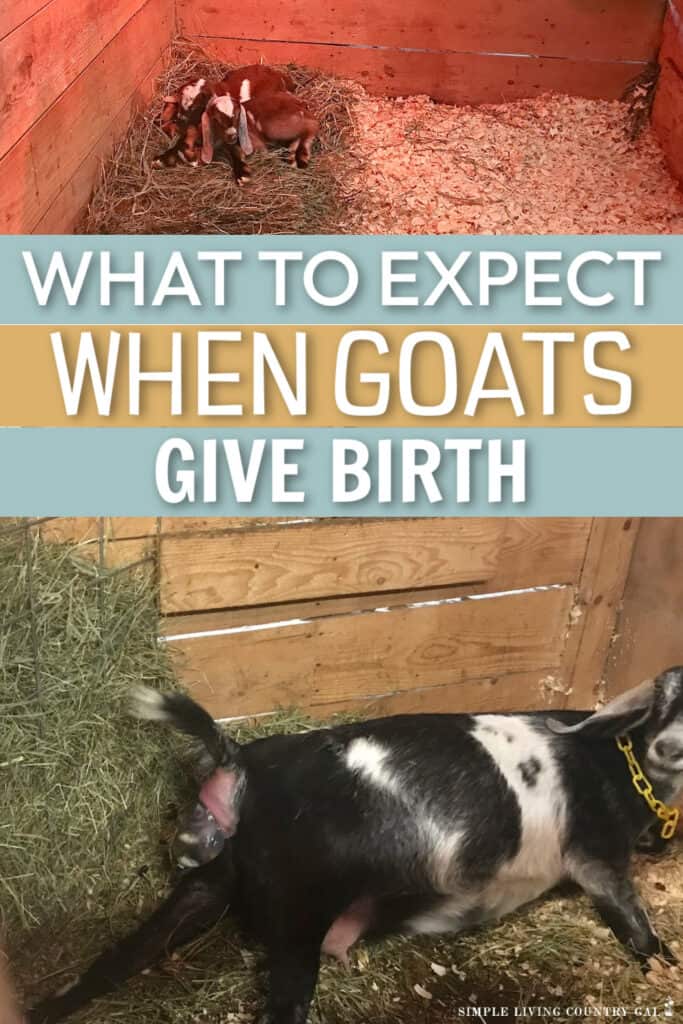
Welcoming new life to your homestead is a thrilling experience, especially if it involves adorable and energetic goat kids. But for a new goat owner, the prospect of their first kidding can also bring about a mix of excitement and, let’s be honest, total fear.
Knowing how things work and what to expect will help you to have a better idea of each step of kidding, which can lower that anxiety level a bit.
The good news is most kiddings go off without any issues, but it’s always good to know how things play out so you can help if needed and give support.
Do I Need to Breed Dairy Goats to Get Milk?
If you raise dairy goats, they will need to be bred and kid in order to produce milk. Goats will produce milk for up to two years if milked consistently. On our homestead, we prefer to breed all of our milking annually to ensure a constant milk supply.
Be sure to grab our FREE Goat Kidding Checklist below!
When are goats bred?
Most goats are bred in the fall with a spring kidding around 5 months later. Timing is the key to ensuring your kiddings happen when you want them.
Use our Goat Gestational Tool Here to help you map out a breeding schedule that fits the timing on your own homestead.
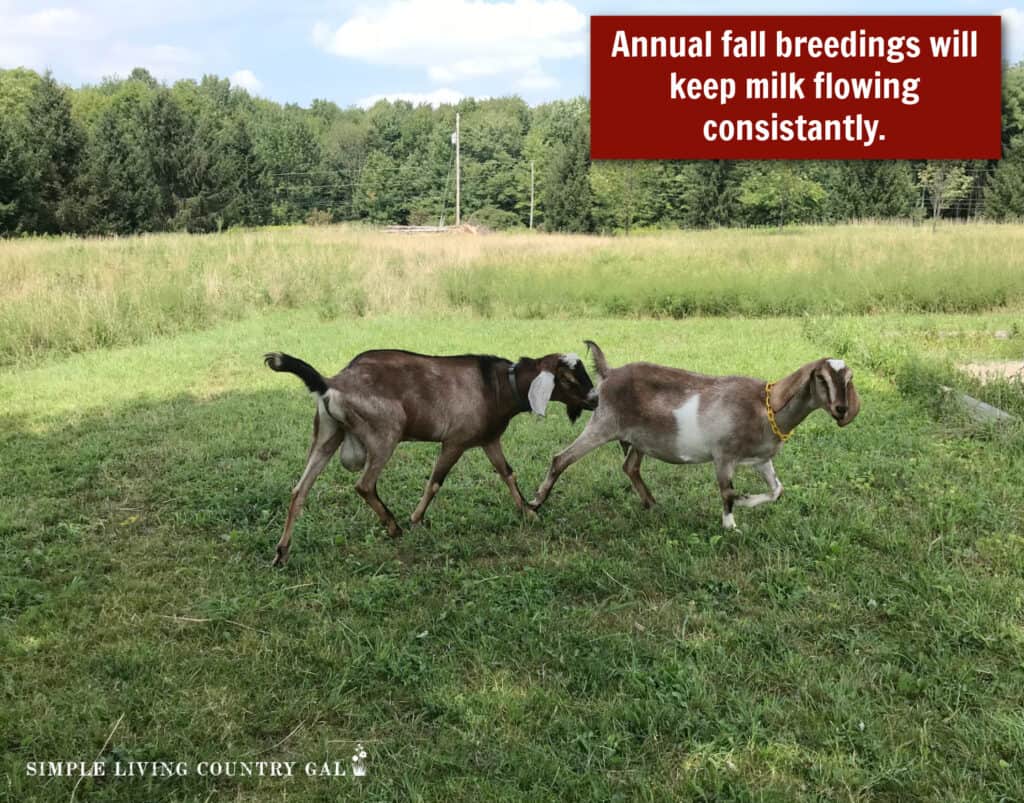
Preparation for Kidding
As your goats approach kidding season, having a few things ready will help you relax before things begin to happen. Even though we have bred dairy goats for many years on our homestead, I still get nervous about the kidding season.
I have learned that the more prepared I can be, the more relaxed I am when the kids arrive. And the more relaxed you are the more comfortable your herd will be as well.
Set up a Birthing Space
Before the big day, ensure your doe has a clean, dry, and warm area for birthing. This ‘kidding pen’ should be separate from the rest of the herd to reduce stress from being around a herd and potential injuries from curious goats.
A space of about 4′ x 5′ per goat is ideal. Be sure to have plenty of clean bedding such as straw and water for the doe and some hay.
Does prefer privacy when kidding, but if you are unable to provide that, you can section off a corner of your goat area with fencing. Not private, but still separate from the herd.
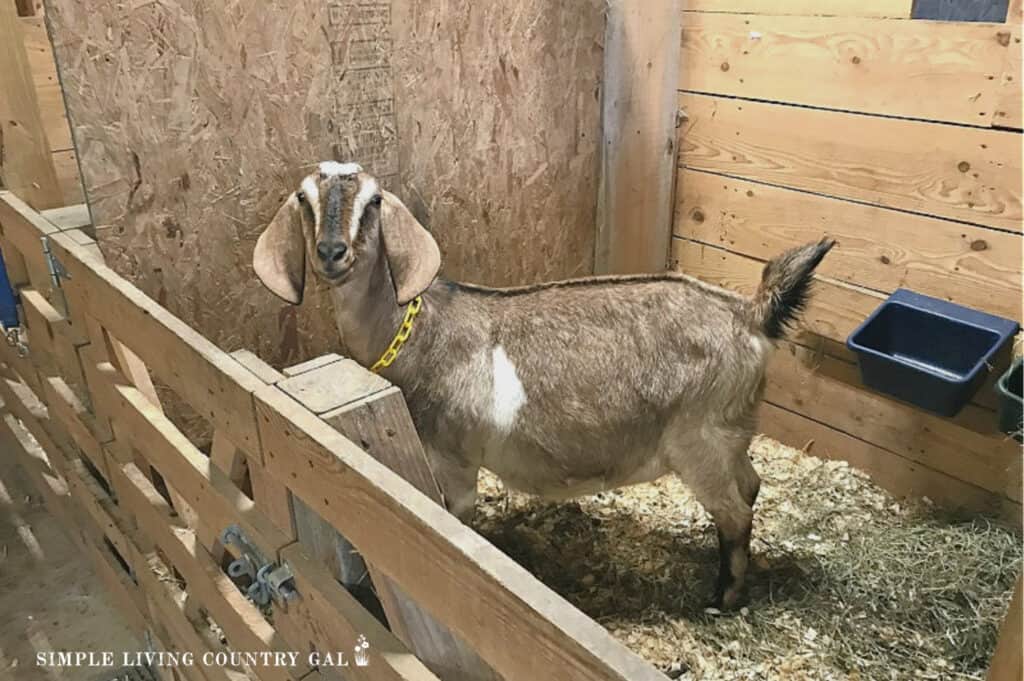
Gather Necessary Supplies
There are a few items you will want to have ready in case you need to assist with kidding. You can gather these items up and keep them in a plastic tote with a label, Goat Birthing Kit.
- Clean towels for drying kids
- Iodine solution for navel dipping
- A thermometer to monitor doe’s temperature
- Mild soap for cleaning and bucket to fill with warm water
- Gloves
- A kidding kit for emergencies that contains a kid puller, scissors, dental floss, and other misc items
- Vaseline or lubricant
Agri-Pro Enterprises Lamb and Goat Kid Feeding Kit 1- Tube (14Fr), 1-Syringe (60 ML)



Signs of Labor
Birthing typically happens around 145–155 days of gestation and there are a few signs to watch for that will help you to know when labor is getting close.
- Your doe may exhibit ‘nesting’ behavior, scratching and pawing at the ground to make a birthing spot.
- Her udder may fill with milk.
- Her ligaments at the tail will start to loosen.
- She may stargaze, looking off into the distance.
- Your doe will start to moan and/or grunt as she begins to push.
- You may see discharge from her back end.
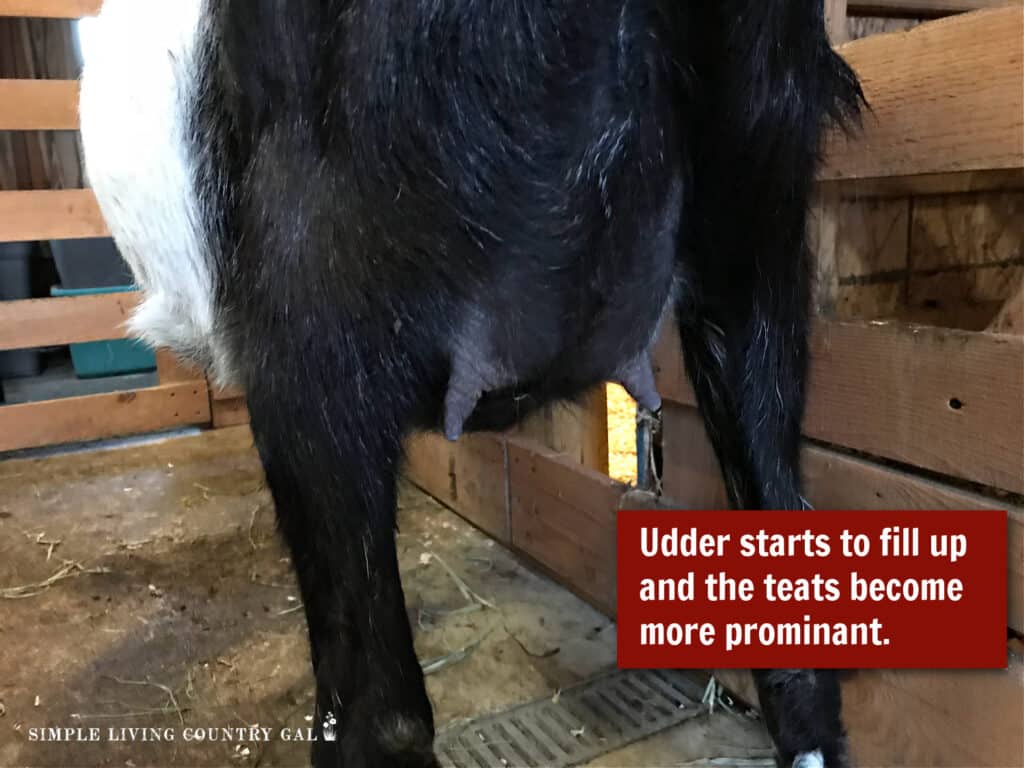
13 Signs Your Goats are About to Kid
During Kidding
Once kidding begins things tend to get a bit more intense. Just remember your goal is to be supportive while keeping your distance. I have found that the more I hover the less progress my doe makes.
Sometimes, a goat will not deliver if stressed or crowded by people. Watch for signs that she may want privacy and try to give her what she needs to do her job.
Signs of Labor starting
Kidding typically begins with contractions. As the cervix dilates, the water sac or bubble may appear at the vagina. This usually breaks as the kid moves into position.
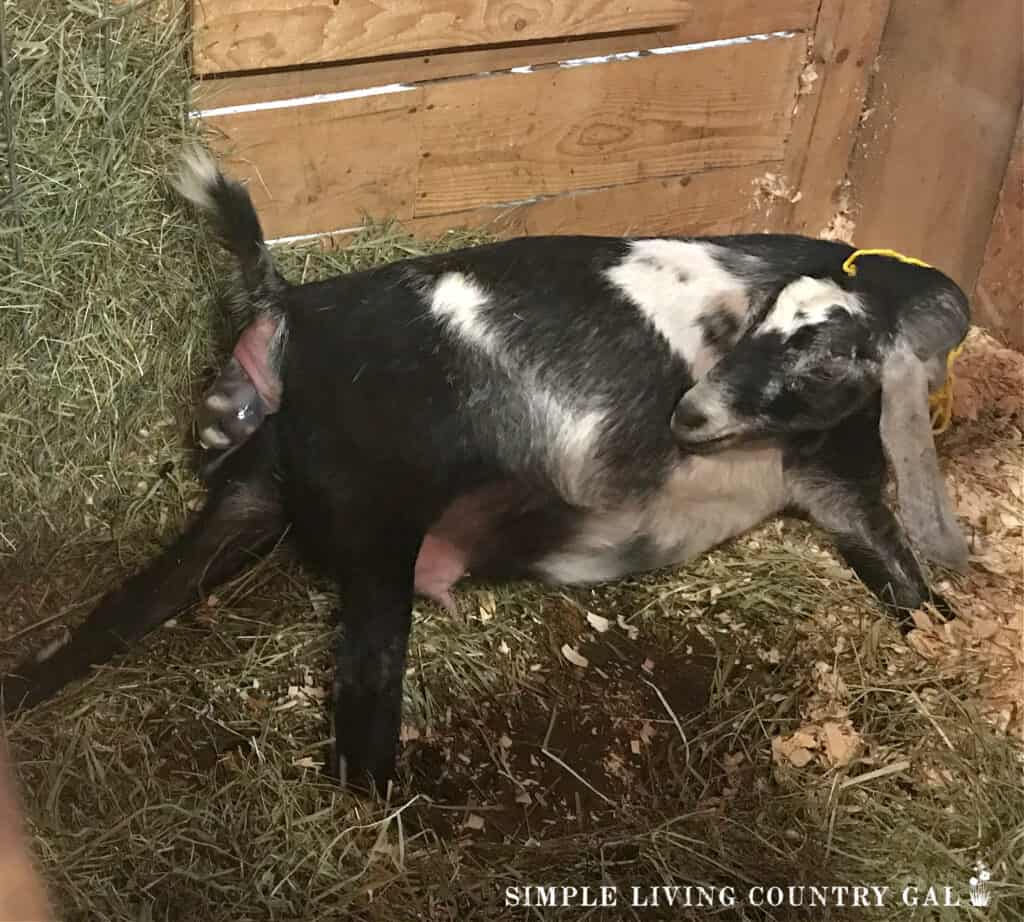
What is the best position for a kid at birth?
You want the kids to present in what is known as a diver’s position. This means their nose and hooves are all present and facing out. if you do not see two hooves and a nose, you will want to monitor her progress to ensure the kid falls into place. Please remember to contact a vet if you need help repositioning a goat kid.
Monitoring the Doe’s Progress
To monitor progress, watch your doe but remember to keep your distance. You want to be there if you need to intervene but not hover to the point that your doe is uncomfortable.
The birthing progress happens as the first kid enters the birth canal. At this point, you may see a clear, stringy mucus discharge. Your doe will likely arch her back, vocalize as a moan all the way up to a yell, and show signs of pushing. She may also push her head up against the wall while pushing.
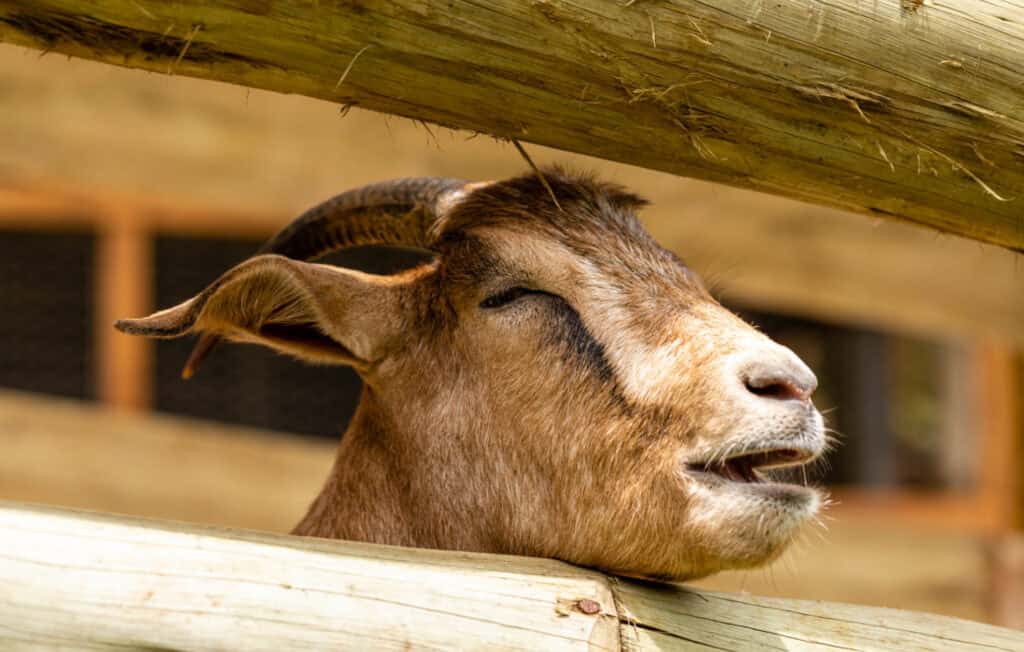
Assisting the Doe If Needed (With Caution)
Sometimes, kids need a little help, especially when a doe has multiples or if this is their first kidding. Going “in” to help position a kid can be risky and may cause injury if not done properly. Only intervene if:
- The doe has been actively pushing for over an hour with no progress.
- The kid is in the wrong position and cannot be corrected by the doe.
We love the book Storey’s Barn Guide to Sheep. Even though it is for sheep, the position issues are the same with goats, and having a visual of what can happen and how to fix each one can be very helpful, especially if you are a visual person.
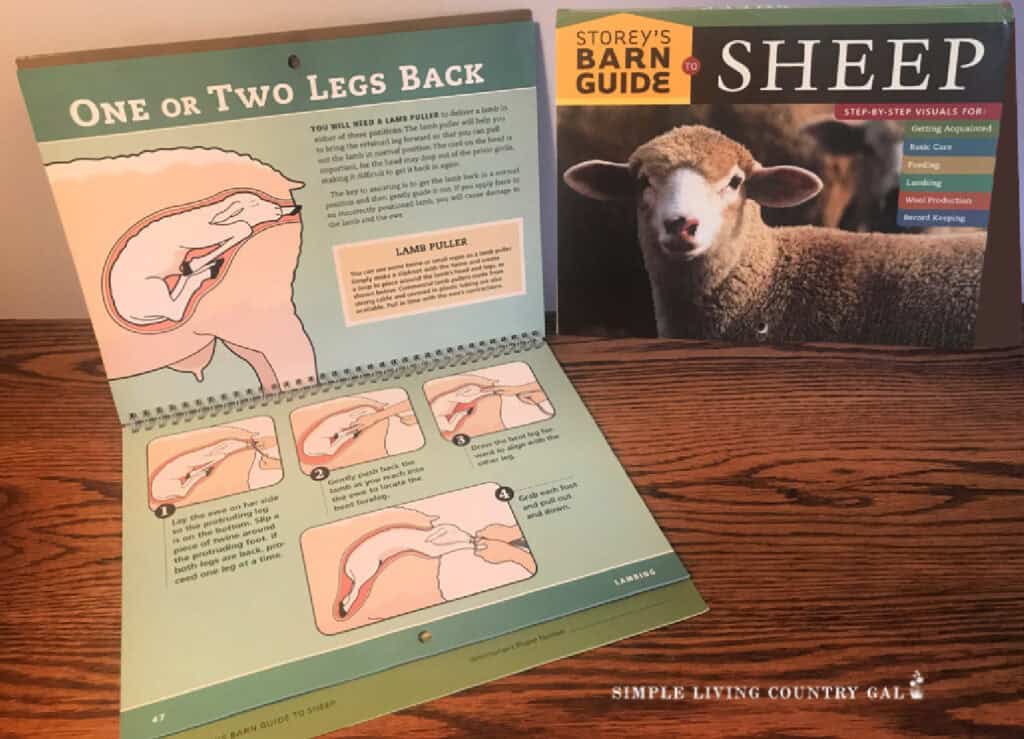
Identifying Signs of Complications
If you notice excessive bleeding, a kid stuck in the birth canal, or a doe showing excessive pain during labor, these are signs of a birthing emergency. Act promptly but with care.
Disclaimer: In accordance with FDA guidelines, the information and products offered on this website are not intended to diagnose, treat, cure, or prevent any disease. I am not a medical professional. Before administering any medications to your animals please contact a veterinarian first.
When to Intervene Versus When to Call a Vet
A good rule of thumb is to intervene only if you are certain you can do so without causing harm. If in doubt, or if the situation doesn’t improve with your help, call a vet immediately.
If you do not have a livestock vet in your area, you will still want to contact him/her to see if they can offer advice if you ever need it. Just because a vet doesn’t deal in livestock doesn’t mean they do not have the education to offer advice on what to do if there is an issue.
Post-Kidding Care
Once the kids are on the ground there are a few things you will want to do to help them get the best start in life.
Initial Health Check of Kids
Immediately after birth, check that each kid is breathing and able to nurse. You want them to stand and nurse within 20-30 minutes of birth.
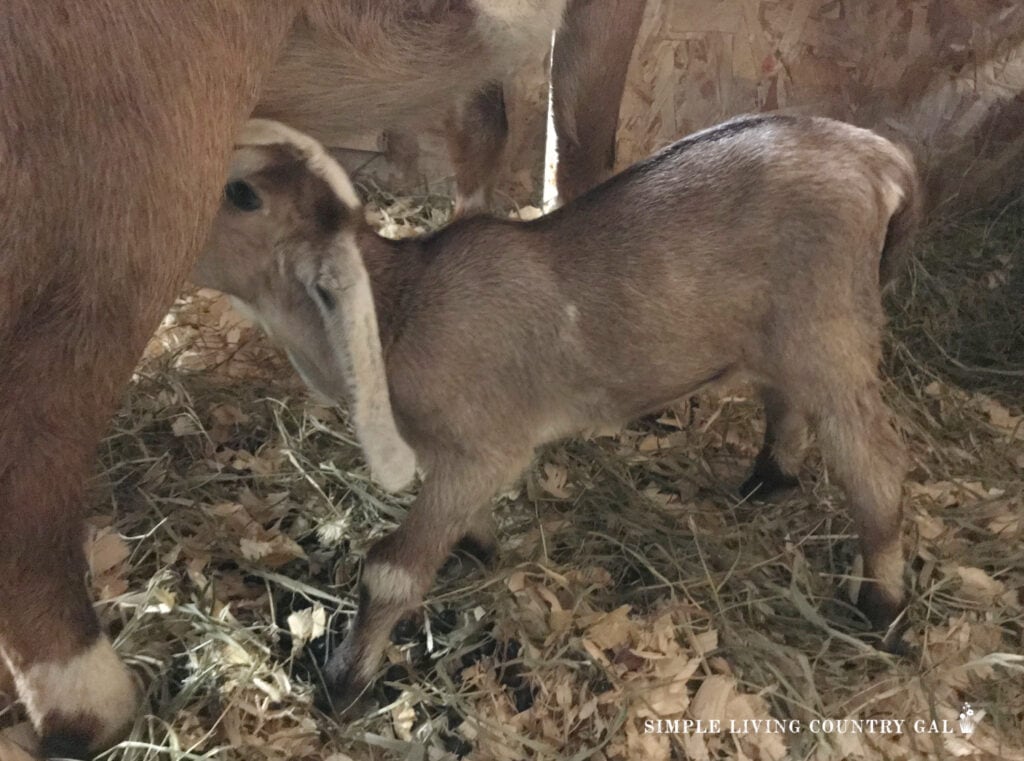
The first milk that a doe gives is called colostrum and it is vital to the health of newborn kids. Colostrum contains antibodies that kids need to help them fight of diseases. We like to stay with out kids to ensure they get that first crucial milk.
What if goat kids are not nursing?
If you have a weak kid that is unable to stand up and nurse, there are a few things you can do to help.
Option #1. Using one hand to cradle the goat under the belly will encourage them to stand. With your other hand gently squeeze one of the teats spray the kids mouth. As they taste it they will usually perk up, try to stand, so they can nurse on their own.
Usually, those first few drinks give an energy boost that is needed for newborns and may be enough to get them up and on their feet.
Option #2. If you find the mother rejecting the kid, you may need to milk out some of the colostrum and try to feed the kid using a bottle.
Option #3. In severe cases, you can use a colostrum replacer. I like to have a bag on hand just in case we have an issue during kidding season.
It is essential to know that kids will not thrive without colostrum. Colostrum contains crucial antibodies that protect kids from illness. Without that first milk, they will be weak throughout their life and, in some cases, may not survive.
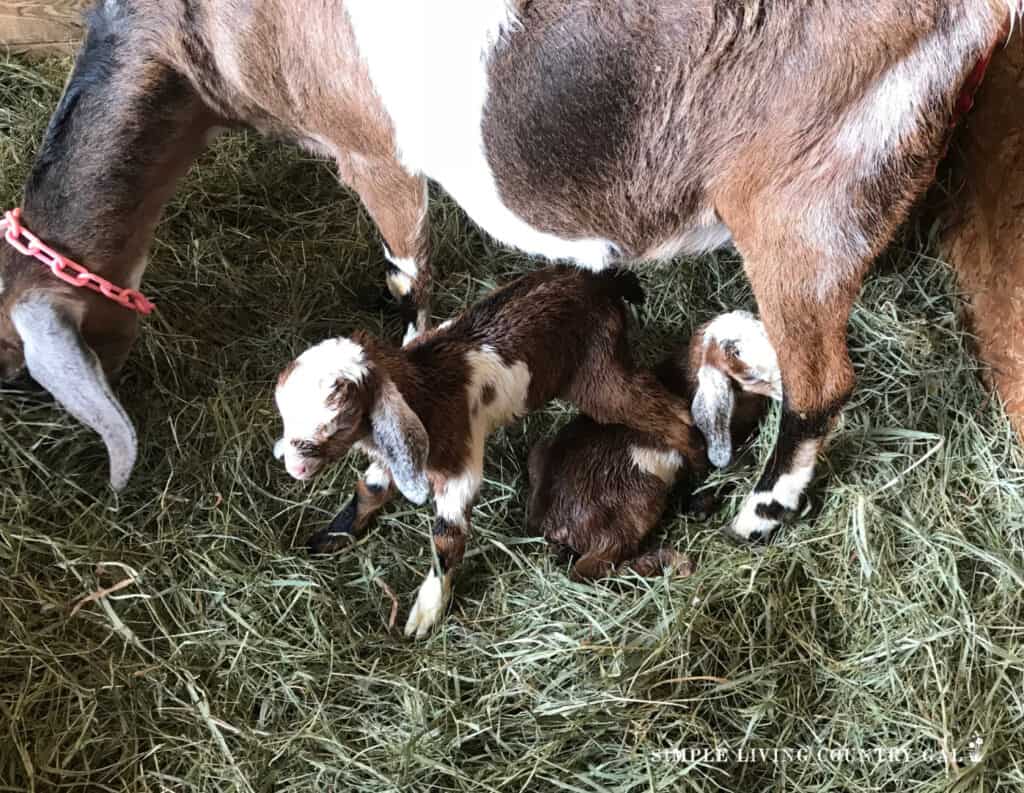
Monitoring the Bonding Process
The doe and kids should be left alone to bond after the initial health check. This is crucial for their long-term well-being. A strong maternal bond is essential for both the doe and the kids.
If you have a doe who is not bonding with her kids, you may need to help her adjust to feeding them. Sometimes, you can help her acclimate to being a mom, and sometimes, you cannot. In severe cases, you may need to take over the mom role and bottle-feed rejected kids.
Bonding Timeline
Immediately after birth – Does will start bonding immediately after birth by cleaning off newborn kids. They will also nudge them with their nose to get familiar with their smell and lick them dry from head to tail.
Within the first hour – Kids should stand and nurse within an hour. Nursing is quick and may only take a few seconds, but it does happen often. Each time they nurse, they strengthen their bond with their mother.
From birth to the first few hours – The mother will bleat consistently to her kids so they will learn her voice. As the kids grow, they will call out to their mom, getting that bleat in return. This will let them know where she is as well as reassure them she is close.
Establishing a Care Routine for the Doe and Kids
Goats thrive on having a routine, and the sooner you can set one up, the better everyone will feel going forward.
The most important is a feeding routine. Each morning and evening, give fresh hay and grain to the mother and replace out the previous day’s water with fresh.
Spend time around the new doe and kids and observe how everyone acts.
- Are the kids walking okay?
- Is the mother allowing them to nurse on demand?
- Are noses clean and free of discharge?
- Is the mother eating and drinking consistently?
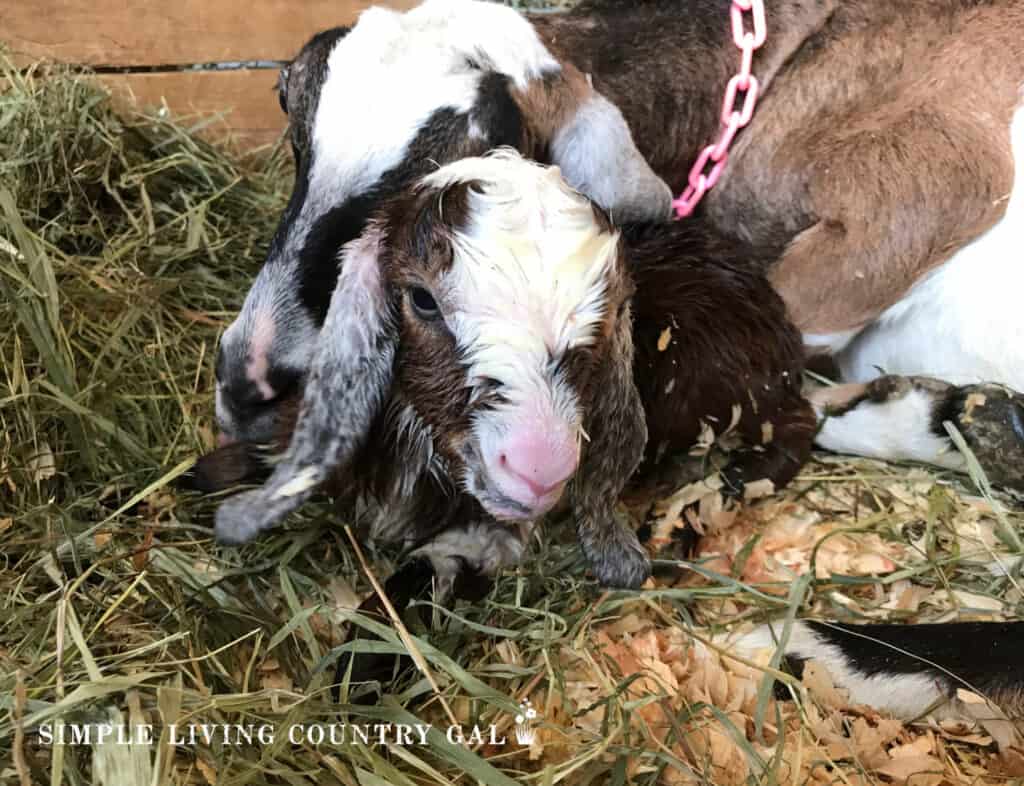
Day-By-Day Guide for the First Week Post-Kidding
- Day 1: Observe kids nursing and bonding, dip the navel in iodine, monitor for signs of illness.
- Day 2: Ensure the kids are strong and vigorous, monitor for dehydration in kids and milk fever in does.
- Day 3: Monitor for scours or diarrhea, ensure does pass afterbirth, start a feeding schedule.
- Day 4: Establish a routine, observe if kids are growing and does are healthy.
Feeding Schedules
Kids should nurse several times within the first 24 hours. Then, they should nurse about every 2 to 4 hours.
Doe Care
A balanced diet, hygiene, and regular milking are essential post-kidding. Observe for retained afterbirth which can cause illness.
The kidding process is a time of both excitement and responsibility. By having an idea of what to expect and the timeline things happen on will hep you to be better able to assist your doe if needed.
Prepping can be helpful when kidding season is around the corner. The more prepared you are the less stressed your goats will feel. Remember this guide and timeline for First Time Goat Kidding season is a good way to enjoy this amazing time on a homestead.
Remember that each kidding experience is unique, and the best preparation of all is to be there and be ready for whatever may happen.





